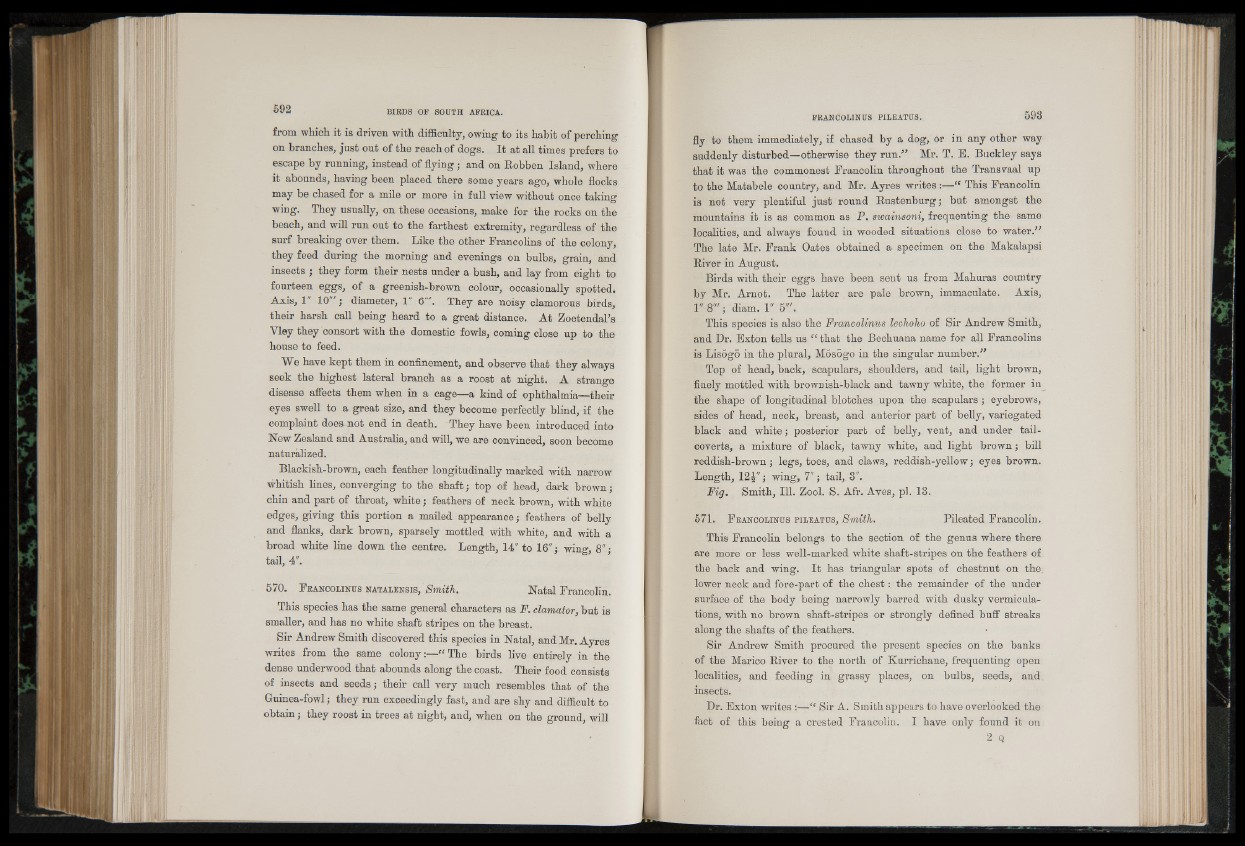
from which it is driven with difficulty, owing to its habit of perching
on branches, just out of the reach of dogs. It at all times prefers to
escape by running, instead of flying; and on Robben Island, where
it abounds, having been placed there some years ago, whole flocks
may be chased for a mile or more in full view without once taking
wing. They usually, on these occasions, make for the rocks on the
beach, and will run out to the farthest extremity, regardless of the
surf breaking over them. Like the other Francolins of the colony,
they feed during the morning and evenings on bulbs, grain, and
insects ; they form their nests under a bush, and lay from eight to
fourteen eggs, of a greenish-brown colour, occasionally spotted.
Axis, 1 10 j diameter, 1" 6". They are noisy clamorous birds,
their harsh call being heard to a great distance. At Zoetendal’s
Vley they consort with the domestic fowls, coming close up to the
house to feed.
We have kept them in confinement, and observe that they always
seek the highest lateral branch as a roost at night. A strange
disease affects them when in a cage—a kind of ophthalmia—their
eyes swell to a great size, and they become perfectly blind, if the
complaint does not end in death. They have been introduced into
New Zealand and Australia, and will, we are convinced, soon become
naturalized.
Blackish-brown, each feather longitudinally marked with narrow
whitish lines, converging to the shaft; top of head, dark brown;
chin and part of throat, white; feathers of neck brown, with white
edges, giving this portion a mailed appearance; feathers of belly
and flanks, dark brown, sparsely mottled with white, and with a
broad white line down the centre. Length, 14" to 16"; wing, 8";
tail, 4".
570. F r a n c o l in u s n a t a l e n s is , Smith. Natal Francolin.
This species has the same general characters as F. clamator, but is
smaller, and has no white shaft stripes on the breast.
Sir Andrew Smith discovered this species in Natal, and Mr. Ayres
writes from the same colony:—“ The birds live entirely in the
dense underwood that abounds along the coast. Their food consists
of insects and seeds; their call very much resembles that of the
Guinea-fowl; they run exceedingly fast, and are shy and difficult to
obtain; they roost in trees at night, and, when on the ground, will
fly to them immediately, if chased by a dog, or in any other way
suddenly disturbed—otherwise they run.” Mr. T. B. Buckley says
that it was the commonest Francolin throughout the Transvaal up
to the Matabele country, and Mr. Ayres writes:—“ This Francolin
is not very plentiful just round Rustenburg; but amongst the
mountains it is as common as P. swainsoni, frequenting the same
localities, and always found in wooded situations close to water.”
The late Mr. Frank Oates obtained a specimen on the Makalapsi
River in August.
Birds with their eggs have been sent us from Mahuras country
by Mr. Arnot. The latter are pale brown, immaculate. Axis,
1" 8'"; diam. 1" 5"'.
This species is also the Francolinus lechoho of Sir Andrew Smith,
and Dr. Bxton tells us “ that the Bechuana name for all Francolins
is Lisogo in the plural, Mosogo in the singular number/’
Top of head, back, scapulars, shoulders, and tail, light brown,
finely mottled with brownish-black and tawny white, the former in
the shape of longitudinal blotches upon the scapulars; eyebrows,
sides of head, neck, breast, and anterior part of belly, variegated
black and white; posterior part of belly, vent, and under tail-
coverts, a mixture of black, tawny white, and light brown ; bill
reddish-brown; legs, toes, and claws, reddish-yellow; eyes brown.
Length, 12£"; wing, 7"; tail, 3".
Fig. Smith, 111. Zool. S. Afr. Aves, pi. 13.
571. F r a n c o l in u s p il e a t u s , Smith. Pileated Francolin.
This Francolin belongs to the section of the genus where there
are more or less well-marked white shaft-stripes on the feathers of
the back and wing. It has triangular spots of chestnut on the.
lower neck and fore-part of the chest: the remainder of the under
surface of the body being narrowly barred with dusky vermicula-
tions, with no brown shaft-stripes or strongly defined buff streaks
along the shafts of the feathers.
Sir Andrew Smith procured the present species on the banks
of the Marico River to the north of Kurrichane, frequenting open
localities, and feeding in grassy places, on bulbs, seeds, and
insects.
Dr. Bxton writes :—“ Sir A. Smith appears to have overlooked the
fact of this being a crested Francolin. I have only found it on
2 Q